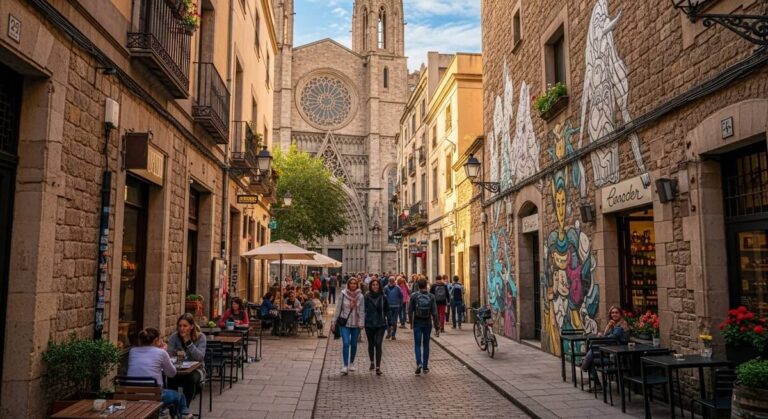Getting Around Paris: A Comprehensive Guide to Public Transport, Taxis, and More
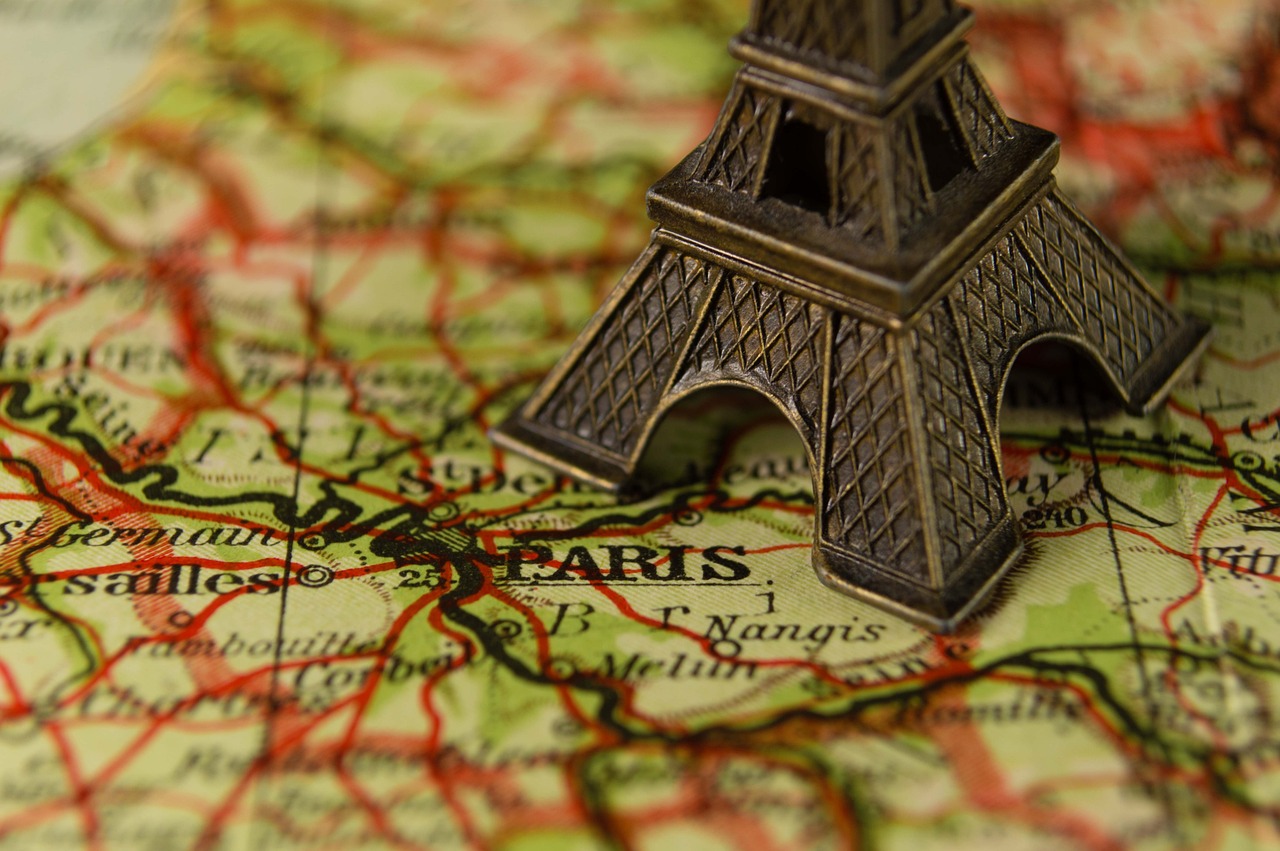
Maneuvering the vibrant city of Paris can seem intimidating at first, but understanding the intricacies of its public transport system, taxis, and various alternative modes of travel can transform your experience.
This guide helps you travel seamlessly across Paris, ensuring you make the most of your visit with essential insights and practical tips. Curious about the best ticket options or the most scenic routes? Let’s explore further.
How to Navigate Your Way Around Paris: Highlights
Hide- Metro System: The Paris Metro offers quick, extensive travel with 16 lines and unlimited access via various ticket options.
- Bus Network: Scenic bus routes cover major landmarks with accessible payment options like the Ticket t+ and Navigo Pass.
- Cycling: Bike-share schemes and dedicated lanes make cycling an eco-friendly way to explore Paris.
- Taxi Services: Taxis provide convenient door-to-door transport, avoiding the crowds and schedules of public transit.
- Paris has a comprehensive public transport network consisting of the metro and RER train systems, buses, and bike-share schemes 🚂
- The metro has 16 lines and is being expanded to add four more lines as part of the Grand Paris Express project 🚧
- The RER has five main lines and is fully integrated with the metro, allowing for easy transfers between trains 🔄
- Buses are widely accessible and a good option for parents with prams and people with limited mobility, with many routes offering scenic views 🚌
- The Batobus is a hop-on, hop-off service that stops at nine key destinations along the Seine, offering a river cruise at a fraction of the price of a tour boat 🚣
- The Vélib’ bike-share scheme has over 20,000 bikes available at 1400 stations citywide, with options for single-trip, day, and multiday passes 🚴
- The Navigo Easy card is the cheapest and easiest way to use public transport in Paris, with options for loading value and buying carnets for discounted rides 💳
- Parking in Paris is costly and difficult, and it's recommended to avoid driving in the city if possible 🚫
- Taxis are available at official stands and via private companies and apps, but can be expensive and may not be the best option for those with limited mobility 🚕
- Trains are the best way to get to and from Paris' airports, with the RER B line connecting to Charles de Gaulle and Orly airports 🛫️
- Paris is not particularly well-equipped for disabled visitors, but efforts are being made to improve accessibility ahead of the 2024 Olympic and Paralympic Games 🏅
- The Paris Tourist Office's website is a useful resource for information on accessibility and practical information for visitors 📚
Getting Around Paris: An Overview

Finding your way around Paris efficiently requires an understanding of the various transportation options available, each tailored to different needs and preferences.
The Metro offers a quick and extensive network for zipping across the city, while buses provide a more scenic and leisurely journey.
For those looking to explore at their own pace, cycling through Paris’ dedicated bike lanes presents an environmentally friendly and flexible alternative.
Keep reading this comprehensive Paris travel guide to better navigate your way around during traveling.
Choosing the Right Mode of Transport: Metro, Bus, or Bike
Moving around efficiently requires an understanding of its various transportation options, each suited to different needs and preferences.
For quick and direct travel, the Metro system provides a comprehensive network of lines and stations. Alternatively, bus routes offer a scenic journey, and bike-share schemes present a flexible, eco-friendly way to explore Paris. Which option do you prefer?
Navigating the Paris Metro System

Maneuvering the Paris Metro system efficiently requires a solid understanding of its thorough map, which details the city’s extensive network of lines and stations.
Purchasing the right metro tickets can be simplified by knowing the various options and where to buy them, while awareness of rush hours can help you avoid the busiest times.
Additionally, the Metro system offers several accessibility features to accommodate travelers with limited mobility, ensuring a smoother journey for all.
Understanding the Metro Map: A Guide to Reading and Interpreting
Efficiently traversing Paris often begins with mastering the intricacies of its metro map, a vibrant tapestry of lines, colors, and symbols that delineate the city’s extensive underground network.
Understanding this map is vital for effectively using public transportation in Paris, empowering you to navigate the city with ease and independence.
To make the most of the metro map, consider these essentials:
- Lines and Colors: Each metro line in Paris is identified by a specific number and color.
- Stations and Interchanges: Pay attention to major interchange stations where multiple lines intersect. These hubs, like Châtelet and Gare du Nord, are pivotal for transferring between lines.
- Endpoint Stations: Each line is defined by its endpoint stations.
- Zone Awareness: While most tourist destinations fall within zones 1-3, being aware of the zonal system can help in planning trips to outlying areas and understanding fare structures.
Mastering the metro map is a key step in how to get around Paris efficiently. This essential tool of Paris transportation guarantees that you can explore the city’s myriad attractions effortlessly.
Buying Metro Tickets: Where to Purchase and Which Ticket to Choose
Understanding the metro map is just the beginning; knowing where to purchase and which type of metro ticket to choose is equally important for a seamless experience traversing Paris’s underground network.
One of the most convenient and economical methods for buying metro tickets is through vending machines located at every metro station. These machines accept coins, banknotes, and credit cards, making them accessible to most travelers.
For those who prefer a more personal touch, metro tickets can also be purchased at ticket counters within larger stations.
When considering which ticket to buy, the single-use ‘Ticket t+’ is a popular choice. It allows transfers between buses, trams, and the RER (within Paris zones) for 90 minutes from first validation.
However, for those planning to explore extensively, the ‘Navigo Découverte’ pass provides unlimited travel on public transportation in Paris for a week or a month, making it the cheapest way to travel in Paris for frequent commuters.
Additionally, options like the ‘Paris Visite’ pass cater to tourists by offering unlimited travel for 1 to 5 days, including discounts at various attractions.
Understanding how to get around in Paris efficiently starts with knowing where to purchase tickets and selecting the right one for your journey.
Rush Hours and Peak Times: How to Avoid the Crowds
To make your journey through the Paris Metro less stressful, it is essential to be aware of rush hours and peak times when the system experiences its highest passenger volumes.
Understanding these times can help you avoid overcrowded trains and stations, enhancing your overall experience with public transportation in France.
Typically, the busiest periods on the Paris Metro are during weekday mornings from 7:30 AM to 9:30 AM and evenings from 5:00 PM to 7:30 PM.
These rush hours coincide with the standard workday, making it challenging for those who seek a more relaxed commute. Additionally, tourist-heavy areas like the Eiffel Tower and Louvre Museum can be particularly crowded during peak tourist seasons.
To avoid the crowds, consider the following:
- Travel Off-Peak: Plan your travel outside the rush hours and peak times mentioned above.
- Use Alternative Routes: Researching less busy routes can save time and stress.
- Consider Paris Taxis: For a more personalized journey, Paris taxis can be an efficient alternative.
- Leverage Apps: Use transportation apps to monitor real-time crowd levels and adjust your plans accordingly.
Accessibility Options: Navigating the Metro with Limited Mobility
Maneuvering the Paris Metro with limited mobility presents unique challenges, but several accessibility options are available to secure a smoother and more inclusive transit experience.
While older stations can be less accommodating, newer or renovated stations often feature elevators, ramps, and tactile guide paths. Key stations like Gare de Lyon and Châtelet-Les Halles have enhanced accessibility, making it easier to travel both within Paris and to cities close to Paris by train.
To better navigate the metro, the RATP website and app offer real-time updates on elevator and escalator status, essential for planning accessible routes.
Priority seating is designated for passengers with reduced mobility, and assistance is available at major stations. For a completely hassle-free experience, consider utilizing the accessible bus network, which covers extensive routes throughout the city.
When the metro proves too challenging, taxis serve as a viable alternative. Knowing how to get a taxi in Paris is straightforward: you can hail one on the street, find a taxi stand, or use apps like G7 or Uber, which offer wheelchair-accessible vehicles.
Exploring Bus Routes and Services
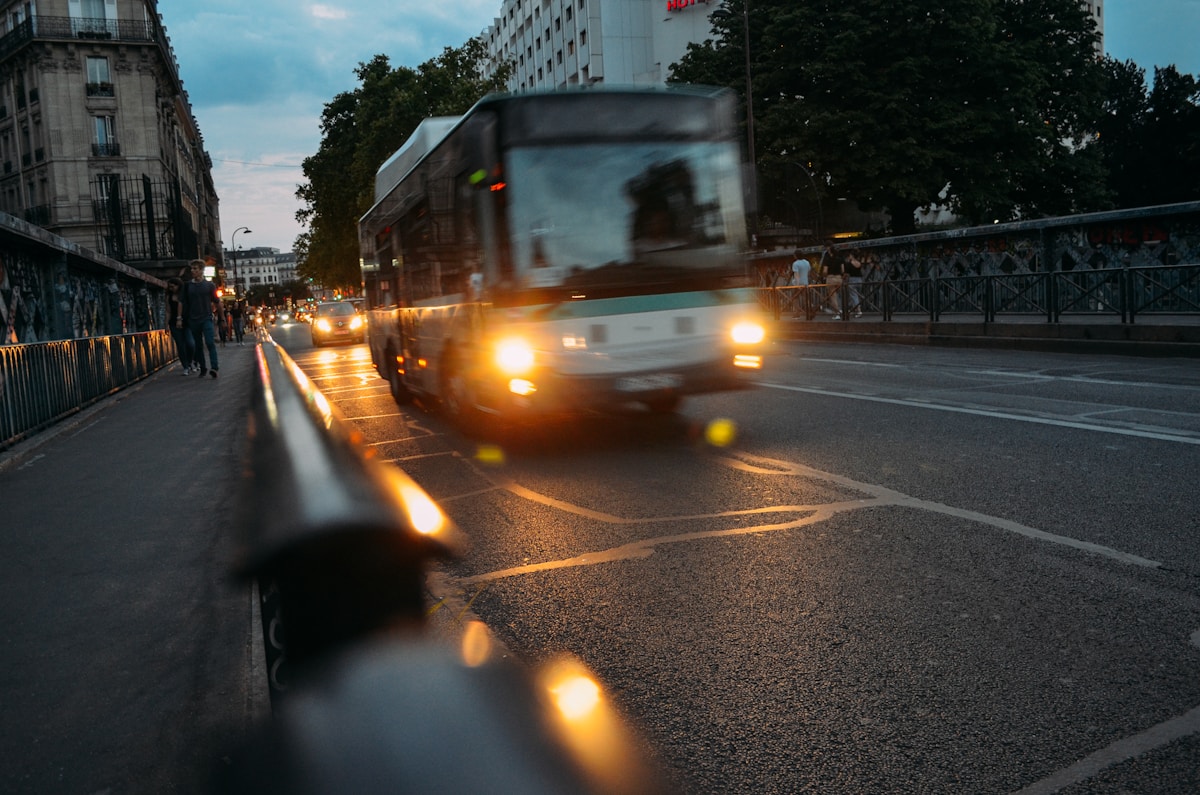
Maneuvering the extensive bus network in Paris can markedly enhance your travel experience, offering scenic routes and accessibility to areas beyond the Metro’s reach.
This section will cover major bus lines and their key destinations, night buses for after-hours travel, fare and payment methods, and essential tips for a comfortable journey.
Whether you’re planning daytime excursions or exploring the city after dark, understanding the bus services will guarantee a smooth and enjoyable trip.
Major Bus Lines and Their Destinations: Your Go-To Guide
Understanding the major bus lines and their destinations in Paris is essential for efficiently exploring the city’s diverse neighborhoods and iconic landmarks.
Paris boasts an extensive bus network that connects major attractions, hidden gems, and local hotspots, offering a cost-effective and scenic alternative to the metro.
To help you navigate, here are four key bus lines and their notable destinations:
- Bus 42: This line runs from Gare Saint-Lazare to the Eiffel Tower. Along the way, it passes through the Champs-Élysées and the Grand Palais, making it ideal for sightseeing.
- Bus 69: Starting at the Champ de Mars and ending at Gambetta, Bus 69 is a favorite among tourists. It traverses the Left Bank, passing landmarks like the Louvre, the Marais district, and the Bastille.
- Bus 72: Operating between the Parc de Saint-Cloud and the Hôtel de Ville, this line offers stunning views of the Seine River and stops at iconic spots like Trocadéro and the Palais de Tokyo.
- Bus 95: Connecting Porte de Montmartre to Porte de Vanves, this line covers Montmartre, Opéra Garnier, and the bustling Saint-Germain-des-Prés.
Night Buses: How to Get Around After Dark
When the sun sets in Paris, an efficient network of night buses, known as Noctilien, guarantees that the city remains accessible and vibrant around the clock.
This extensive service operates between 12:30 AM and 5:30 AM, covering routes that connect major hubs like train stations, key districts, and suburban areas.
Noctilien boasts over 40 routes, each beginning with an ‘N’ to distinguish them from daytime services. For instance, N01 and N02 are circular routes that encompass the heart of Paris, ensuring seamless travel within central areas.
Meanwhile, routes such as N120 connect the city center with far-flung suburbs, catering to both locals and visitors who venture beyond the metropolitan core.
Strategically designed for convenience, Noctilien buses run at intervals of 10 to 30 minutes, ensuring minimal wait times even at the late hour.
Informative maps and real-time tracking via the RATP app enhance the user experience, making navigation straightforward.
Whether returning from an evening out in Montmartre or catching an early flight from Charles de Gaulle Airport, Noctilien provides a reliable and safe option to traverse Paris after dark, embodying the spirit of freedom and exploration.
Bus Fare and Payment Methods: Everything You Need to Know
To fully benefit from Paris’s extensive bus network, understanding the fare system and available payment methods is key.
Paris offers a variety of ticket options to suit diverse travel needs, ensuring users can navigate the city with ease. Here’s what you need to know:
| Ticket Type | Description | Price | Details |
|---|---|---|---|
| Single Ticket (Ticket t+) | A single journey ticket valid for buses and trams, allowing transfers within 90 minutes. |
|
Transfers between buses and trams allowed within 90 minutes. |
| Navigo Pass | Offers unlimited travel on buses, metros, RER, and trams within selected zones. |
|
Ideal for frequent travelers. Available for weekly or monthly periods. |
| Contactless Payment | Allows payment via bank cards or mobile apps (e.g., Apple Pay, Google Pay) on Paris buses. | Same as Single Ticket (Ticket t+) | Convenient and charges the same fare as a single Ticket t+. |
| Carnet of Tickets | A book of 10 tickets at a discounted rate, can be shared with others. | €14.90 | Offers a reduced rate compared to single tickets. |
Tips for a Comfortable Bus Journey: What to Expect and How to Prepare
Maneuvering Paris’s bus routes effectively requires a bit of preparation, but with these tips, your bus journey through Paris will be both efficient and enjoyable.
- Familiarize yourself with the RATP bus network, which has over 60 lines, each marked by a number.
- Use the RATP app or website to check your route, stops, and transfer points to minimize delays.
- Get to the bus stop a few minutes early to secure a good spot, especially during peak hours. Buses display route numbers clearly on the front and sides.
- Make sure to validate your ticket using the machines on board to avoid fines from random checks.
- For a more comfortable ride, try to travel during off-peak times when buses are less crowded. You’ll often find seating towards the back.
- Keep an eye on your belongings, offer seats to those in need, and follow bus etiquette—by avoiding loud conversations and keeping aisles clear.
Also read our guide on Parisian etiquette and safety and security in Paris for more convenient travels.
The Convenience of RER Trains

The RER trains in Paris offer a swift and efficient means of traversing both the city and its suburban areas, distinguishing themselves from the Metro system through their broader reach and faster speeds.
Understanding the differences between the Metro and RER, traversing major stops and connections, and mastering the ticketing process are essential for leveraging this service.
Additionally, the RER is particularly useful for day trips to popular destinations like Versailles, making it an indispensable part of Parisian public transport.
Differences Between Metro and RER: Understanding the Key Distinctions
Steering through the transportation system in Paris, it’s crucial to recognize the key distinctions between the Metro and the RER, particularly the convenience offered by RER trains.
The RER, or Réseau Express Régional, serves as a rapid transit system that extends beyond the city limits, providing an efficient means of travel for both residents and tourists alike.
Here are four key distinctions highlighting the convenience of RER trains:
- Extensive Coverage: The RER network extends beyond central Paris, connecting the city to suburbs and regional destinations, making it ideal for exploring beyond the urban core.
- Faster Travel: RER trains are faster than Metro trains, cutting down travel time, especially for longer trips. They are perfect for quick commutes across Paris and its outskirts.
- Higher Capacity: With larger trains and fewer stops in central Paris, the RER handles more passengers, reducing congestion and improving the travel experience during peak times.
- Seamless Integration: The RER is well-integrated with the Metro, enabling easy transfers between systems. This connectivity simplifies travel planning and offers greater flexibility for your journey.
Navigating RER Lines: Major Stops and Connections
Steering through the RER lines in Paris involves understanding major stops and connections, which greatly enhances the convenience and efficiency of travel within the city and its surrounding regions.
The Reseau Express Regional (RER) comprises five lines, labeled A through E, each serving a wide array of key destinations.
For instance, the RER A is instrumental for reaching Disneyland Paris and the La Défense business district. Similarly, the RER B line directly connects travelers to Charles de Gaulle Airport, facilitating seamless international travel.
Key transfer points are essential for maximizing the RER’s utility. Châtelet-Les Halles, one of the world’s largest underground stations, serves as a pivotal interchange, linking multiple metro and RER lines.
Gare du Nord is another critical hub, offering connections to Eurostar services and various regional trains. Such nodes guarantee that whether your journey involves a short hop to a suburban locale or a venture further afield, the RER network supports a fluid changeover.
Moreover, the RER’s integration with the Paris Metro enhances its flexibility, allowing for easy shifts between the two systems.
This integration is particularly beneficial for reaching cultural sites like the Louvre, Notre-Dame, and Versailles, underscoring the RER’s crucial role in Parisian transport.
Buying and Using RER Tickets: A Step-by-Step Guide
Finding your way through the RER lines with ease also involves understanding the process of buying and using RER tickets, which is vital for a seamless travel experience in Paris.
The RER system, a network of express trains connecting central Paris to its suburbs, can be navigated effortlessly with the right preparation.
Here’s a step-by-step guide to help you:
- Purchase Tickets: RER tickets can be bought from automated machines at any RER station or at ticket counters. You can use credit cards or cash for the transactions. Confirm you select the correct zones for your journey.
- Validate Tickets: Before boarding, validate your ticket by inserting it into the validation machines located at station entrances. This step is essential to avoid fines during ticket inspections.
- Boarding the Train: Check the electronic boards for train schedules and platform numbers. Make certain you board the right train heading towards your destination, especially during peak hours.
- Keep Your Ticket: Retain your validated ticket until the end of your journey, as you will need it to exit the station at your destination.
This streamlined process guarantees you can explore Paris and its surrounding areas efficiently, granting you the freedom to enjoy your travels without hassle.
RER for Day Trips: Visiting Versailles and Other Outskirts
Exploring the outskirts of Paris for memorable day trips from Paris becomes a breeze with the convenience of RER trains, offering efficient and direct routes to popular destinations like Versailles.
The RER (Réseau Express Régional) network is a robust system that connects the heart of Paris to its greater metropolitan area, making it an ideal choice for travelers looking to experience more than just the city center.
The RER C line is your gateway to the opulent Palace of Versailles, a UNESCO World Heritage site known for its stunning gardens and historic significance.
Departing frequently from central Paris stations like Saint-Michel and Invalides, the RER C takes you directly to Versailles Château Rive Gauche in approximately 40 minutes.
Beyond Versailles, the RER network extends to other remarkable sites such as Disneyland Paris via the RER A line, and the medieval city of Provins on the RER P line.
These reliable, timely services offer an unparalleled sense of freedom, allowing you to explore the rich culture and history that lie just beyond Paris’s borders.
Cycling Through Paris
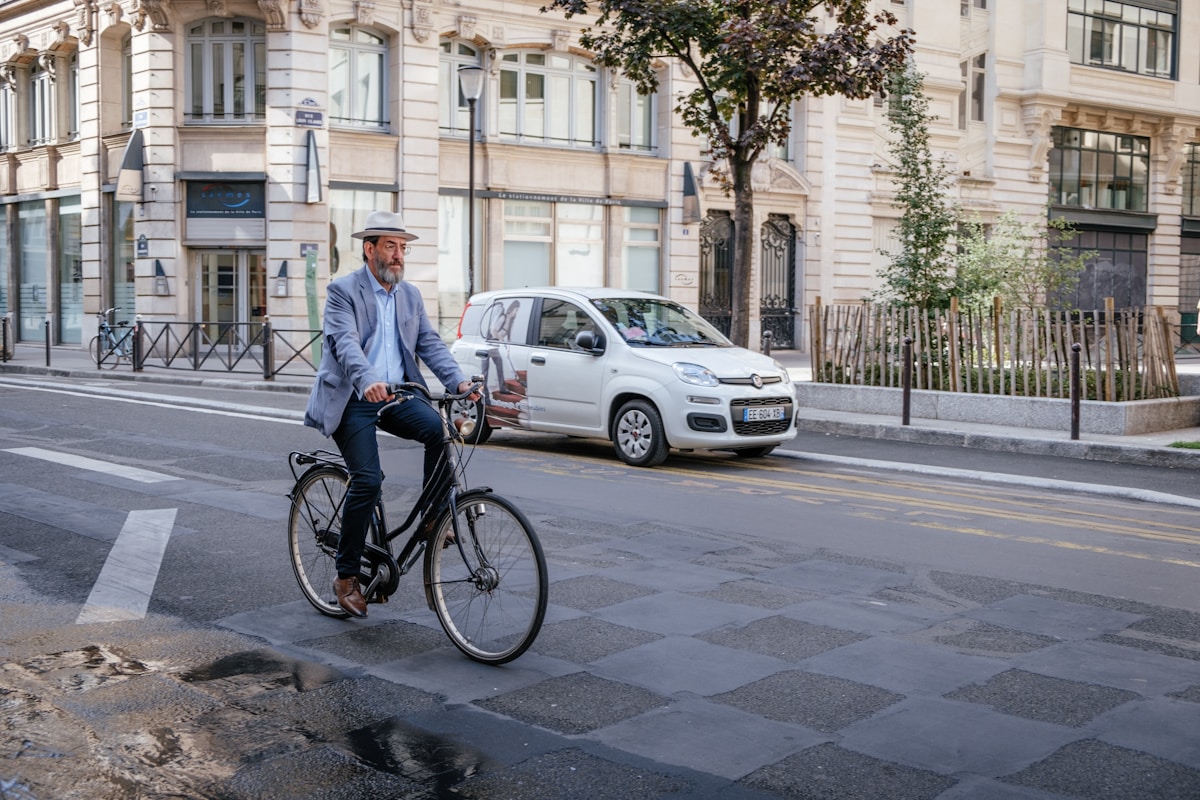
Cycling offers an eco-friendly and scenic way to navigate Paris, whether renting a Velib bike or exploring popular cycling routes.
Understanding safety tips and familiarizing yourself with dedicated bike lanes and local regulations will enhance your experience and guarantee a smooth journey through the city’s picturesque streets.
This section will guide you through the essentials of cycling in Paris, from getting started with a Velib bike to discovering the best routes and safety practices.
Renting a Velib Bike: How to Get Started
Starting on a journey through Paris by renting a Vélib’ bike offers an efficient and eco-friendly way to explore the city’s iconic landmarks. To get started, follow these simple steps to guarantee a seamless experience:
- Register Online or via App: Begin by subscribing to the Vélib’ service through their official website or mobile app. You can choose between short-term passes or annual memberships based on the duration of your stay.
- Locate a Vélib’ Station: With over 1,400 stations across Paris, finding a Vélib’ bike is easy. Use the app to locate the nearest station, which will also show the availability of both regular and electric bikes.
- Release Your Bike: Once at the station, use the app or your Vélib’ card to release a bike. Follow the prompts to detach the bike from its docking station. Confirm you inspect the bike for any damages before riding.
- Return and Dock: After your ride, return the bike to any Vélib’ station. Push the bike firmly into an empty dock until you hear a beep confirming it is securely locked.
Popular Cycling Routes: Best Ways to See the City by Bike
Once you’ve secured your Vélib bike, commence on one of Paris’s popular cycling routes to experience the city’s charm and history from a unique vantage point.
Start your journey along the Seine River, where the scenic Berges de Seine offers a car-free route featuring picturesque views of iconic landmarks such as the Eiffel Tower and Notre-Dame Cathedral. This route is ideal for those who wish to soak in the city’s beauty at a leisurely pace.
For a more immersive experience, navigate through the Marais district. This historic area is rich with narrow, cobblestone streets, vibrant cafés, and hidden gardens.
Alternatively, venture through the expansive Bois de Boulogne park. Spanning over 2,000 acres, this green oasis offers a tranquil escape from the bustling city. With numerous trails and lakes, it’s a perfect spot for nature enthusiasts looking to unwind.
Safety Tips for Cyclists: Staying Safe on Paris Streets
To guarantee a safe and enjoyable cycling experience on the bustling streets of Paris, it is essential to familiarize yourself with important safety guidelines and local traffic regulations.
Maneuvering the city’s dynamic environment on a bike can be thrilling, yet it requires vigilance and adherence to safety practices to protect both yourself and others.
Here are four important safety tips for cyclists in Paris:
- Wear a Helmet: Although not mandatory for adults, wearing a helmet greatly reduces the risk of head injuries. Prioritizing your safety by wearing a helmet can make a considerable difference.
- Use Reflective Gear and Lights: Equip your bike with front and rear lights, and wear reflective clothing to enhance your visibility to motorists, especially during low light conditions or at night.
- Obey Traffic Signals and Signs: Treat traffic lights and signs with the same respect you would if driving a car. Adhering to these rules not only protects your safety but also contributes to smoother traffic flow.
- Stay Alert: Always be aware of your surroundings. Watch out for opening car doors, pedestrians, and other cyclists. Anticipate the actions of others and be prepared to react accordingly.
Dedicated Bike Lanes and Regulations: What Every Cyclist Should Know
Maneuvering the streets of Paris by bike is made considerably easier and safer by the city’s extensive network of dedicated bike lanes and thorough cycling regulations.
Paris has invested heavily in creating over 1,000 kilometers of bike-friendly routes, integrating cyclists seamlessly into the urban landscape.
These lanes are clearly marked, often separated from motor vehicle traffic by physical barriers, providing a safer environment for cyclists.
Cyclists must adhere to specific regulations designed to guarantee safety and order. Helmets are recommended, especially for younger cyclists, though not mandatory for adults.
Wearing reflective gear and using lights during evening rides is compulsory. Additionally, Paris enforces strict traffic rules for cyclists, including respecting traffic signals and pedestrian crossings.
Navigating the city also means being aware of shared spaces where cyclists coexist with pedestrians and vehicles; these areas require heightened attentiveness and courtesy.
The city’s bike-sharing program, Vélib’, offers an affordable and convenient option for both residents and tourists, supporting the city’s vision of a more sustainable and accessible urban environment.
Using Taxis and Ride-Sharing Services
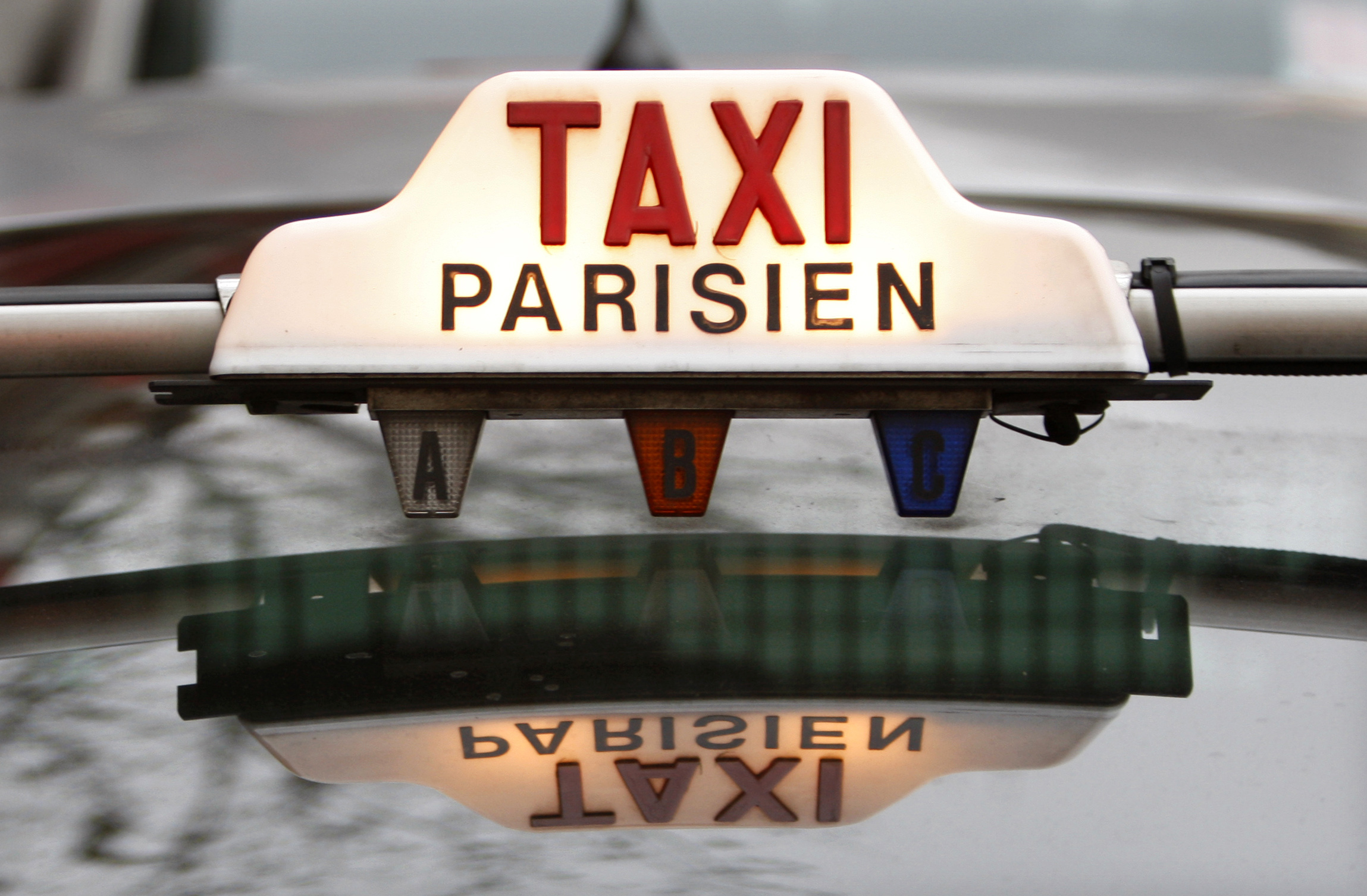
When traversing Paris, understanding the nuances of using traditional taxis and ride-sharing services can greatly enhance your travel experience.
Learn how to hail a taxi, explore convenient alternatives like Uber, and compare costs to make informed decisions.
Additionally, familiarize yourself with safety protocols and etiquette to guarantee a smooth journey.
Traditional Taxis: How to Hail and What to Expect
Traversing the bustling streets of Paris by taxi offers a convenient and efficient option for both tourists and locals alike.
Traditional taxis in Paris, identifiable by their illuminated ‘TAXI’ signs, provide a reliable means of transportation, especially when steering through the city’s intricate layout or during late hours.
Here’s how to hail a taxi and what to expect:
- Hailing a Taxi: Look for taxis at designated stands, typically found near major landmarks, train stations, and busy streets. You can also flag one down if the ‘TAXI’ sign is lit green, indicating availability.
- Metered Fares: Parisian taxis operate on metered fares, which vary based on the time of day and traffic conditions. Confirm the meter is reset at the start of your journey to avoid overcharging.
- Payment: Most taxis accept both cash and credit cards, but it’s advisable to confirm with the driver beforehand. Tipping is appreciated but not obligatory.
- Language: While many taxi drivers speak basic English, having your destination written down or a map can be helpful.
Uber and Other Rideshare Options: Convenient Alternatives
Although traditional taxis remain a staple of Parisian transportation, rideshare services like Uber offer a modern, often more flexible alternative for traversing the city’s vibrant streets.
Uber, along with its competitors such as Bolt and Kapten, provides a seamless experience through user-friendly mobile apps.
These apps allow you to book a ride with just a few taps, track your driver in real-time, and pay electronically, eliminating the need for cash transactions.
Rideshare services are particularly convenient for visitors who prefer a door-to-door service without the complexities of maneuvering public transport.
Whether you’re heading to a business meeting, a late-night event, or simply exploring Paris, rideshare options can be summoned to your exact location, often within minutes.
Moreover, language barriers are minimized as the apps typically include features to communicate with your driver directly, ensuring a smoother experience.
For those conscious of their carbon footprint, many rideshare platforms offer eco-friendly options like electric or hybrid vehicles.
Comparing Costs: Taxi vs. Ride-Share Services
Comparing the costs of traditional taxis and rideshare services in Paris reveals considerable differences that can influence your choice of transportation.
While both options provide convenience, their pricing structures and additional fees can vary greatly, affecting your overall travel experience.
- Base Fare: Traditional taxis in Paris typically have a higher base fare compared to rideshare services. This initial cost can make taxis seem more expensive at the outset.
- Distance and Time Rates: Taxis charge based on both distance and time, which can add up quickly during traffic congestion. Rideshare services often offer more consistent pricing models, providing a clearer estimate before you even book your ride.
- Surge Pricing: Rideshare services like Uber may implement surge pricing during peak hours or special events, considerably increasing the cost. Taxis do not have such a pricing mechanism, offering a more predictable fare.
- Additional Fees: Taxis may include extra charges for luggage, late-night rides, or trips to and from the airport. Rideshare services generally include these costs in the quoted fare, making it easier to budget.
Understanding these cost components can help you make an informed decision based on your budget and travel needs while traversing the beautiful streets of Paris.
Safety and Etiquette: Dos and Don’ts When Using Rideshares
While understanding the cost differences is important, knowing the dos and don’ts of safety and etiquette when using taxis and rideshare services in Paris can greatly enhance your travel experience.
First and foremost, always verify the vehicle’s license plate and the driver’s photo with the information provided in your app. This simple step guarantees you are getting into the correct vehicle.
When it comes to etiquette, greet your driver with a polite ‘Bonjour’ to start on the right foot. It’s customary to sit in the back seat unless otherwise directed by the driver. Avoid eating or drinking in the vehicle to maintain cleanliness and show respect for the driver’s property.
For added security, share your trip details with a trusted friend or family member. Most rideshare apps offer this feature, providing peace of mind. Additionally, confirm you have a clear and safe place to be dropped off, especially at night.
Lastly, tipping is appreciated but not obligatory in Paris. A small tip or rounding up the fare can be a kind gesture for excellent service. By following these guidelines, you can enjoy a safe, respectful, and pleasant journey through the City of Light.
Walking Tours and Pedestrian Tips
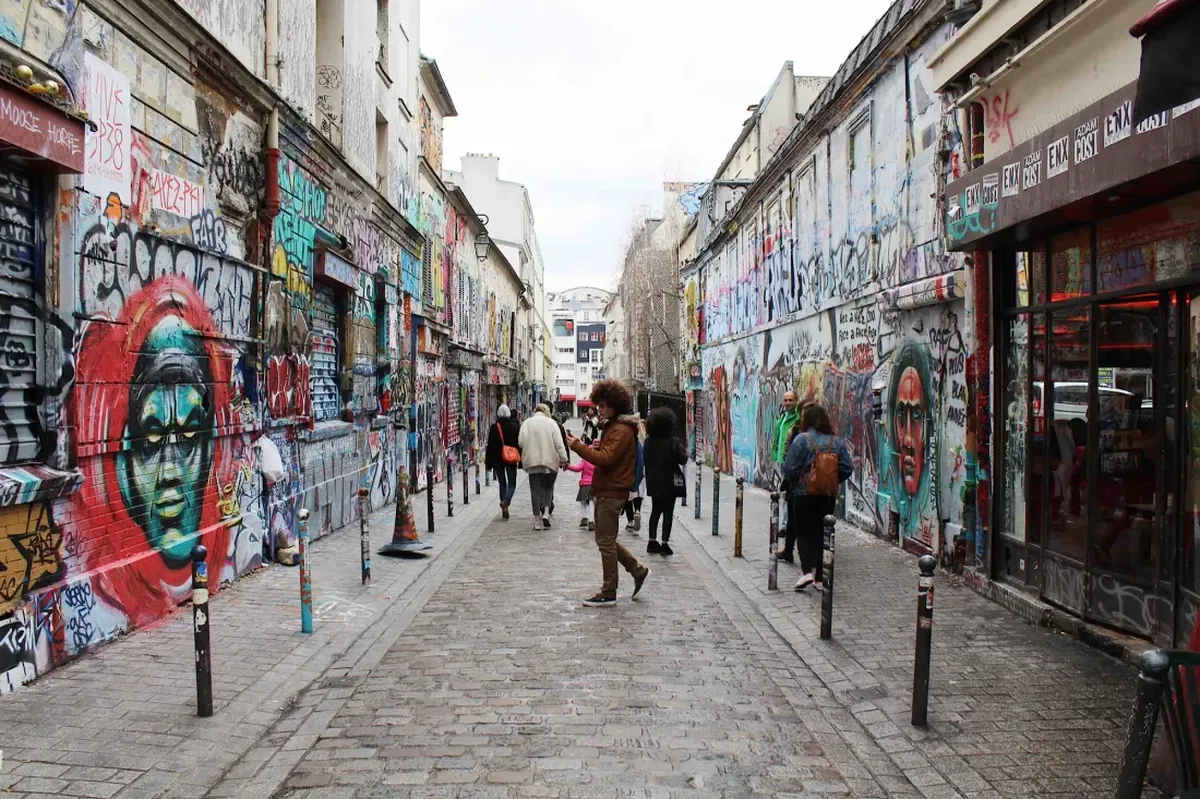
Walking tours in Paris offers an intimate way to experience the city’s charm, from its historic arrondissements to its hidden gems.
Understanding the layout of Paris and following recommended walking routes can greatly enhance your exploration.
To guarantee a safe and comfortable journey, it’s crucial to stay alert, follow pedestrian safety tips, and equip yourself with the right walking gear.
Recommended Walking Routes: Explore Paris by Foot
Exploring Paris by foot allows travelers to uncover the city’s hidden gems through meticulously curated walking routes that showcase its rich history, vibrant culture, and stunning architecture.
Paris, with its walkable streets and charming arrondissements, offers an unparalleled pedestrian experience.
Here are four recommended walking routes that will immerse you in the Parisian vibe:
- Montmartre Stroll: Begin at Place des Abbesses and make your way up to the iconic Sacré-Cœur Basilica. This route takes you through the artistic heart of Paris, with stops at the Wall of Love and various artist studios.
- Latin Quarter Adventure: Start at the Pantheon and explore the winding streets lined with bookshops, cafes, and historical landmarks in Paris like the Sorbonne University and the Luxembourg Gardens.
- Marais Discovery Tour: Wander through the narrow streets of Le Marais, starting at Place des Vosges. Discover hidden courtyards, vibrant street art, and the Jewish quarter’s rich history.
- Seine River Walk: Enjoy a leisurely walk along the Seine, from the Eiffel Tower to Notre-Dame Cathedral. This route offers breathtaking views of iconic landmarks, including the Louvre and Musée d’Orsay.
Each of these routes promises an unforgettable journey through the essence of Paris, allowing you to experience the city at your own pace.
Navigating Paris Arrondissements: Understanding the City’s Layout
Maneuvering the distinct Paris arrondissements is essential for any traveler seeking to fully appreciate the city’s unique character and geographical charm.
Paris is divided into 20 arrondissements, spiraling out like a snail shell from the 1st arrondissement in the historical heart of the city. Each arrondissement offers its own flavor, from the elegant boutiques of the 1st to the bohemian vibes of the 18th.
Walking is one of the most rewarding ways to explore these diverse areas. Begin with the 1st arrondissement, home to the Louvre and the Tuileries Garden.
Meander through the narrow streets of Le Marais in the 4th, rich with medieval history and trendy shops. The Latin Quarter in the 5th is perfect for a leisurely stroll amidst historic universities and vibrant cafes.
For a panoramic view, climb the steps of Montmartre in the 18th, and absorb the artistic legacy of this iconic neighborhood. The 7th arrondissement, where the Eiffel Tower resides, offers broad avenues and picturesque views.
Embrace the freedom to wander; each arrondissement unfolds its own narrative, inviting you to immerse yourself in the enchanting tapestry of Parisian life.
Safety Tips for Pedestrians: Staying Alert and Aware
Guaranteeing your safety while traversing the bustling streets of Paris is paramount to enjoying your pedestrian adventures in this vibrant city.
The charm of Paris lies in its walkability, but it is vital to stay alert and aware to navigate safely. Here are some essential tips to help you stay safe:
- Crosswalk Awareness: Always use designated crosswalks and adhere to pedestrian signals. Even when the signal is green, make sure that drivers have noticed you before stepping onto the road.
- Watch for Cyclists: Paris is a cyclist-friendly city, and cyclists often share the pedestrian pathways. Stay vigilant and keep an eye out for bike lanes to avoid unexpected collisions.
- Avoid Distractions: It is easy to get engrossed in the beauty around you, but avoid distractions like texting or listening to music at high volumes. Staying focused on your surroundings can prevent accidents.
- Night-time Precautions: If you plan to walk after dark, stick to well-lit areas and avoid secluded streets. Carrying a small flashlight or using your phone’s light can enhance visibility.
Essential Walking Gear: What to Bring for a Comfortable Stroll
To make the most of your pedestrian explorations in Paris while staying safe, it is important to equip yourself with the right walking gear.
First and foremost, invest in a pair of comfortable, supportive walking shoes. Paris’s charming cobblestone streets and expansive boulevards can be hard on your feet, so proper footwear is essential to avoid fatigue and discomfort.
Next, consider a lightweight, weather-appropriate jacket. Parisian weather can be unpredictable, with sudden rain showers or cool breezes even in summer. A compact, foldable jacket can easily be stowed in your daypack when not in use.
Speaking of daypacks, opt for a small, secure bag to carry essentials like a water bottle, snacks, a map, and perhaps a portable phone charger.
Don’t forget sun protection—sunglasses and a hat can shield you from the sun’s glare. Additionally, a small, refillable water bottle will keep you hydrated as you navigate the city’s many attractions.
Finally, a compact umbrella or a rain poncho can be a lifesaver on those unexpected rainy days, ensuring that your exploration remains uninterrupted.
With these essentials, you can explore Paris with comfort and ease, fully embracing the freedom of walking through its historic streets.
Alternative Transport Options
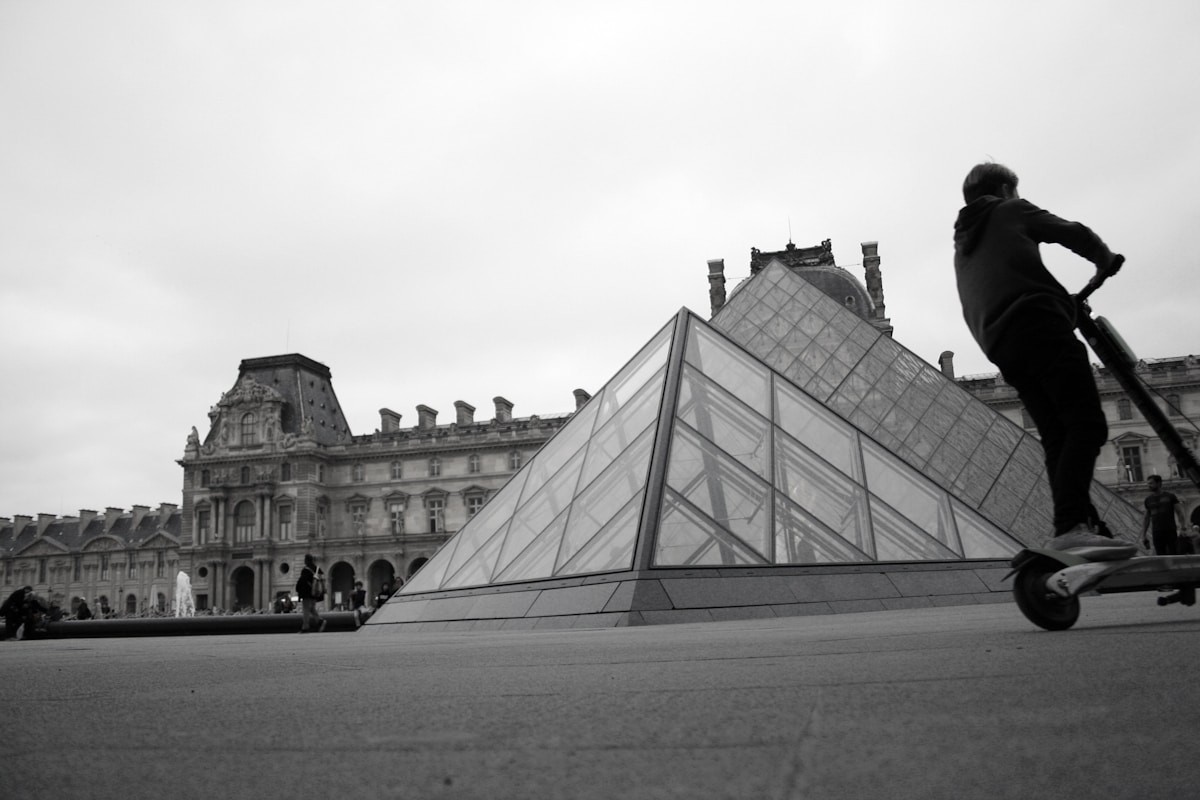
For those seeking diverse modes of transportation in Paris, several alternative options can enhance your travel experience.
Electric scooters provide a quick and eco-friendly way to navigate the city, while river shuttles and boats offer a scenic and leisurely perspective from the Seine.
Additionally, car rentals and the city’s efficient tram system present unique advantages and challenges for exploring Paris.
Electric Scooters: How and Where to Rent
Traversing Paris with electric scooters offers a convenient and eco-friendly alternative to traditional transport options, making it easier for visitors to explore the city’s many attractions.
Electric scooters have become increasingly popular, thanks to their ease of use and the freedom they provide.
To rent an electric scooter in Paris, follow these easy steps:
- Download a Scooter App: Popular choices include Lime, Bird, and Dott. These apps are available for both iOS and Android devices and provide a map of nearby scooters.
- Create an Account: Sign up with your email, phone number, and payment details. Most apps require a valid credit card for renting.
- Locate and Access a Scooter: Use the app’s map to find a scooter near you. Once you reach it, scan the QR code on the scooter to access it.
- Ride and Park Responsibly: Follow local traffic laws, wear a helmet, and park your scooter in designated areas to avoid fines.
Electric scooters are ideal for short commutes and sightseeing, offering a blend of convenience and sustainability.
This mode of transport allows you to experience Paris at your own pace, unburdened by the constraints of more traditional transportation methods.
River Shuttles and Boats: Seeing Paris from the Water
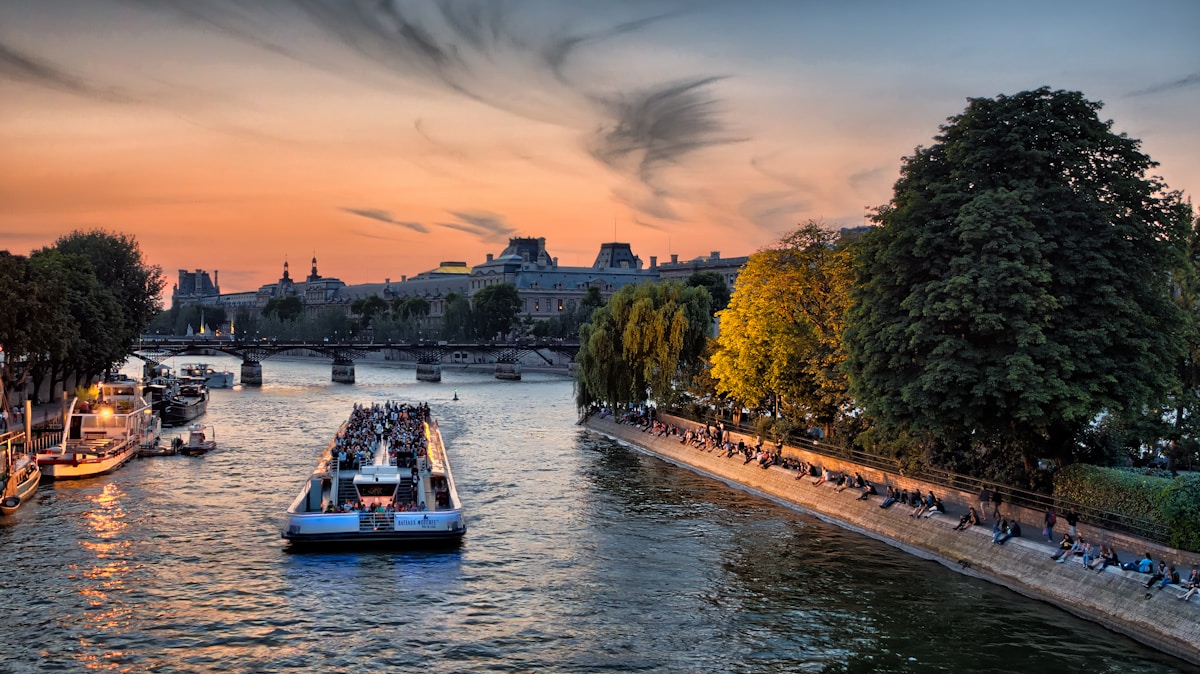
Exploring Paris via river shuttles and boats offers a unique and picturesque perspective of the city’s iconic landmarks, providing an enjoyable and scenic alternative to traditional land-based transport options.
The Seine River, which meanders gracefully through the heart of Paris, serves as a liquid highway connecting many of the city’s most famous attractions, including the Eiffel Tower, Notre-Dame Cathedral, and the Louvre Museum.
River shuttles, such as the Batobus, offer hop-on-hop-off services that allow passengers to explore different neighborhoods at their own pace.
These shuttles are equipped with comfortable seating and panoramic windows, ensuring a pleasurable journey while soaking in the breathtaking views.
Additionally, various boat tours are available, ranging from short sightseeing cruises to romantic dinner cruises, each providing a unique narrative about Paris’s rich history and culture.
For the more adventurous, there are also options for renting electric boats, allowing individuals to chart their own course along the Seine.
These self-navigated vessels offer an unparalleled sense of freedom and flexibility, perfect for those looking to experience Paris from a different vantage point.
Navigating Paris by water is not just a mode of transport—it is an experience that enriches one’s understanding and appreciation of the City of Light.
Car Rentals: Pros and Cons of Driving in Paris
While traversing Paris by water offers a serene and scenic journey, opting for car rentals presents a different set of advantages and challenges for those who prefer the flexibility and independence of driving through the city’s bustling streets.
Renting a car can be particularly appealing for travelers who value the freedom to explore at their own pace and venture beyond the well-trodden tourist paths.
However, driving in Paris is not without its complexities. Here are some critical considerations:
- Traffic Congestion: Paris is notorious for its traffic jams, especially during peak hours. Maneuvering through crowded streets can be time-consuming and stressful.
- Parking Difficulties: Finding a parking spot in central Paris can be a Herculean task. Public parking fees are high, and free spaces are scarce.
- Environmental Zones: Certain areas in Paris require vehicles to display a Crit’Air sticker, indicating their emission levels. Non-compliance can result in fines.
- Driving Etiquette: Parisian driving culture may differ from what you’re used to. Busy intersections, aggressive driving, and numerous roundabouts require a confident and attentive driver.
While car rentals provide unparalleled autonomy, potential drivers must weigh these factors carefully to guarantee a pleasant experience in the City of Light.
Paris’ Tram System: Routes and How to Use
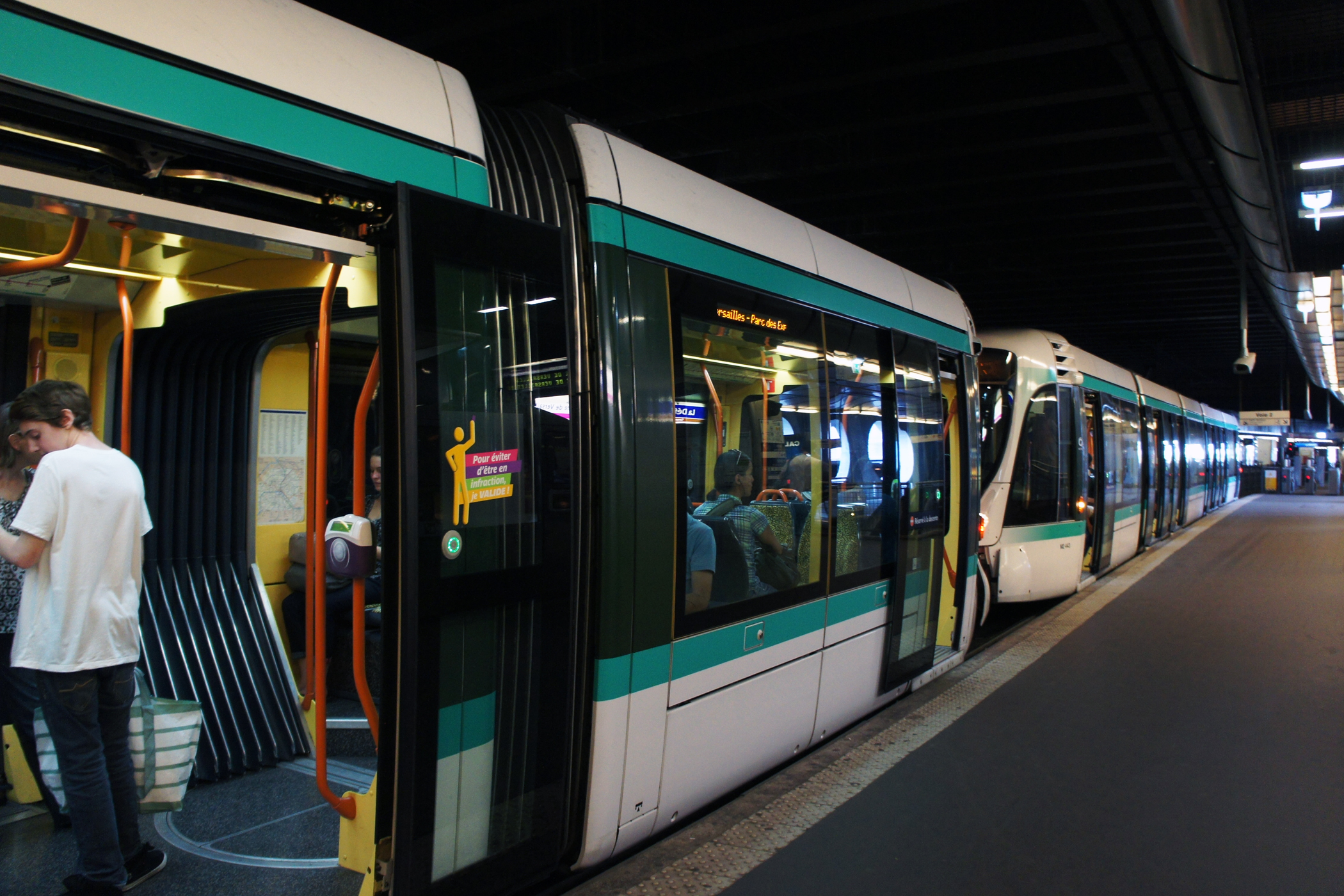
The Paris tram system, comprising over 100 kilometers of tracks, offers a reliable and efficient mode of transport for traversing the city’s extensive urban landscape. W
ith ten operational lines, denoted T1 through T9 and a recently inaugurated T11, the tram network primarily serves the outer arrondissements and suburban zones, effectively complementing the Metro system.
To use the trams, passengers need a valid ticket or pass, which can be purchased at tram stations or via mobile applications.
The trams run daily from 5:30 AM to 12:30 AM, with extended hours on weekends and public holidays. Routes are clearly marked, and digital displays provide real-time updates on arrival times, guaranteeing minimal waiting.
Tram travel is advantageous for those seeking a scenic, unhurried journey, with ample opportunities to observe Parisian neighborhoods. The trams are fully accessible, featuring low floors and designated spaces for wheelchairs and strollers.
For those looking to explore the city with a sense of freedom, the tram system provides a stress-free alternative to driving and a more intimate experience than the Metro.
Whether commuting or sightseeing, the Paris tram system guarantees a seamless and enjoyable transit experience.
Saving Money and Maximizing Convenience
Steering through Paris efficiently while keeping costs low requires strategic planning and smart use of available resources.
Opting for the right transport passes and discounts, leveraging city apps and online tools, and combining various modes of transport can greatly enhance your experience.
Additionally, local tips and hacks from Parisians can offer invaluable insights to streamline your journey.
Transport Passes and Discounts: Choosing the Best Option
Selecting the most suitable transport pass in Paris involves evaluating various options that cater to different needs and budgets, ensuring both savings and convenience for travelers.
With a myriad of choices available, it is essential to select a pass that aligns with your itinerary and duration of stay.
Here are four popular transport passes to contemplate:
- Navigo Découverte: Ideal for those staying a week or more, this pass offers unlimited travel on buses, trams, metro, and RER trains within selected zones. It provides excellent value for frequent travelers.
- Paris Visite Pass: Available for 1, 2, 3, or 5 days, this pass is perfect for tourists. It includes unlimited travel across various zones and offers discounts at numerous attractions, making it a convenient choice for sightseeing.
- Mobilis: This one-day pass provides unlimited travel within specific zones. It is a cost-effective choice for day trips or those with a less structured schedule.
- Carnet of 10 Tickets: For travelers who do not require unlimited travel, purchasing a bundle of single tickets offers flexibility and savings compared to buying individual tickets.
Selecting the right pass can greatly enhance your Parisian experience by maximizing both your time and budget.
Using City Apps and Online Tools: Enhancing Your Travel Experience
Frequently leveraging city apps and online tools can greatly enhance your travel experience in Paris by saving money and maximizing convenience.
The Paris Metro app, for instance, is invaluable for traversing the intricate subway network. It provides real-time updates on train schedules and potential delays, ensuring you can plan your journey efficiently.
Additionally, the RATP app offers extensive information on buses, trams, and RER trains, making it easier to find the quickest routes and avoid unnecessary waiting.
For those keen on eco-friendly transport, the Vélib’ Métropole app allows users to locate and rent bicycles across the city. This app also informs you about available docking stations and bike paths, promoting a seamless cycling experience.
Meanwhile, the Citymapper app combines various modes of transport, from walking to public transit, to offer the most efficient travel options based on your preferences.
To maximize savings, apps like LeCab and Kapten often offer promotional codes and discounts for taxi services, while platforms like Trainline can secure the best deals on regional trains.
Combining Transport Modes: Efficient Route Planning Tips
Efficiently combining different modes of transport in Paris can considerably enhance your travel experience by reducing costs and minimizing transit times.
With a well-integrated transport system that includes the metro, buses, trams, bicycles, and taxis, travelers can navigate the city with ease. Here are some tips to help you plan your route effectively:
- Use Navigo Pass: This weekly or monthly travel card allows unlimited travel on the metro, buses, trams, and RER trains within designated zones. It’s a cost-effective option for frequent travelers.
- Leverage Vélib’: Paris’s bike-sharing system, Vélib’, offers an eco-friendly and flexible way to navigate shorter distances. Combining cycling with metro rides can be both time-saving and enjoyable.
- Strategize Transfers: When planning your route, consider transfer points where different transport modes intersect. Apps like Citymapper can suggest the most efficient transfer combinations.
- Avoid Peak Hours: To maximize convenience, plan your travel outside of peak hours (8-10 AM and 5-7 PM). This reduces crowding and guarantees a more comfortable journey.
Local Tips and Hacks: Insider Advice from Parisians
Steering through Paris like a local involves mastering a few insider tips that can save you money and enhance your overall travel experience.
One key strategy is to invest in a Navigo Découverte pass, which offers unlimited travel across buses, metros, trams, and RER trains within specified zones for a fixed weekly or monthly fee. This pass is particularly cost-effective for longer stays.
Moreover, consider using the Vélib’ bike-sharing system for short distances. With over 1,400 stations citywide, Vélib’ provides a flexible and affordable way to navigate the city, especially in areas less accessible by metro.
When dining out, avoid eateries near major tourist attractions. Instead, venture into neighborhoods like the Latin Quarter or Le Marais, where you’ll find high-quality meals at more reasonable prices.
For those who enjoy markets, visiting local farmers’ markets, such as Marché Bastille, not only saves money but also offers fresh, local produce.
Lastly, download apps like Citymapper or RATP to optimize your transit routes and stay updated on any service disruptions.
These tools are invaluable for real-time navigation and ensuring you can getting around Paris with minimal hassle, maximizing both your time and budget.







